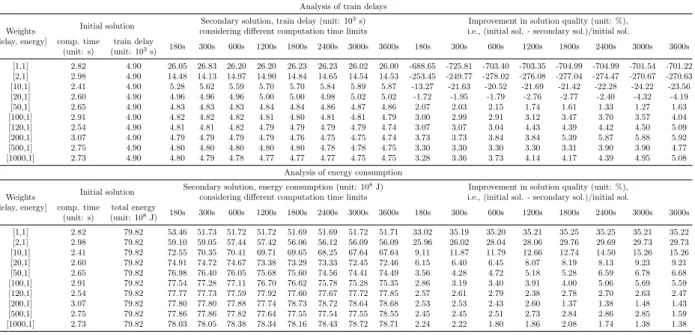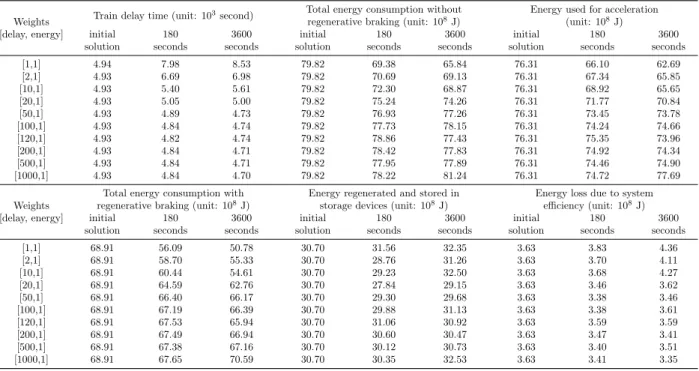Research Collection
Dataset
Integration of real-time traffic management and train control for rail networks
Supplementary material
Author(s):
Corman, Francesco Publication Date:
2018
Permanent Link:
https://doi.org/10.3929/ethz-b-000256447
Rights / License:
In Copyright - Non-Commercial Use Permitted
This page was generated automatically upon download from the ETH Zurich Research Collection. For more information please consult the Terms of use.
ETH Library
Appendix C Detailed experimental results for Part 2
Table 1 provides the objective values of the P
NLPproblem and the P
TSPOproblem, in the case of using the weighted-sum formulation.
Table 1. Objective value of the P
NLPproblem and the P
TSPOproblem with the weighted-sum formulation, corresponding to Fig. 2
Weights [delay, energy]
Objective value of the PNLPproblem considering different computation time limits
Objective value of the PTSPOproblem considering different computation time limits
Improvement in objective value (unit: %) 180 seconds 3600 seconds initial solution 180 seconds 3600 seconds 180 seconds 3600 seconds
[1,1] 89.75 89.68 84.72 79.51 77.70 11.41 13.36
[2,1] 94.12 93.75 89.63 88.05 85.16 6.45 9.17
[10,1] 132.47 132.72 128.85 125.31 126.37 5.40 4.79
[20,1] 184.43 184.38 177.87 174.02 172.82 5.64 6.27
[50,1] 344.62 343.94 324.96 318.67 317.47 7.53 7.70
[100,1] 611.63 606.10 570.06 559.52 554.79 8.52 8.47
[120,1] 723.09 710.08 668.12 655.51 646.98 9.35 8.89
[200,1] 1142.58 1111.18 1060.31 1035.79 1027.54 9.35 7.53
[500,1] 2535.81 2430.29 2531.04 2477.81 2452.05 2.29 -0.90
[1000,1] 4874.70 4749.70 4982.22 4875.38 4824.12 -0.01 -1.57
Table 2 presents the objective values of the two problems, in the case of using the ε-constraint formulation.
Table 2. Objective value (i.e., energy consumption) of the P
NLPproblem and the P
TSPOproblem with the ε-constraint formulation, corresponding to Fig. 3
Initial delays
Objective value of the PNLPproblem (unit: 108J), considering different computation time limits
Objective value of the PTSPOproblem (unit: 108J), considering different computation time limits
Improvement in objective value (unit: %) 180 seconds 600 seconds initial solution 180 seconds 300 seconds 600 seconds 180 seconds 600 seconds
Idelayinitial 80.08 79.34 79.82 76.74 76.14 75.49 4.16 4.04
I180sdelay 91.70 88.85 92.18 89.60 89.28 89.19 2.29 -0.49
I300sdelay 95.14 93.60 96.59 93.81 93.79 93.77 1.40 -0.20
I300sdelay 96.41 95.08 97.53 95.04 94.78 94.73 1.42 0.32
I3600sdelay 99.34 98.78 99.60 97.60 96.65 96.65 1.76 2.16
Table 3 provides the detailed results of the P
NLPproblem by using the weighted-sum formulation and the ε-constraint formulation respectively, in terms of train delay time and energy consumption. The unit of computation time and computation time limit is second, the unit of train delay time is 10
3second, and the unit of energy consumption is 10
8J.
Table 3. Detailed results of the P
NLPproblem, in terms of train delay time and energy consumption
Weights [delay, energy]
Weighted-sum formulation
Initial delays
constraint formulation
180 seconds 3600 seconds 180 seconds 600 seconds
train delay (unit: 10
3s)
total energy (unit: 10
8J)
train delay (unit: 10
3s)
total energy (unit: 10
8J)
train delay (unit: 10
3s)
total energy (unit: 10
8J)
train delay (unit: 10
3s)
total energy (unit: 10
8J)
[1,1] 46.37 43.38 49.83 39.85
Iinitialdelay4.90 80.08 4.90 79.34
[2,1] 16.51 61.10 16.66 60.44
I180delay4.69 91.70 4.69 88.85
[10,1] 5.24 80.05 5.26 80.08
I300delay4.60 95.14 4.60 93.60
[20,1] 5.20 80.38 5.20 80.31
I600delay4.58 96.41 4.58 95.08
[50,1] 5.29 80.04 5.29 79.20
I3600delay4.54 99.34 4.54 98.78
[100,1] 5.31 80.29 5.27 79.27
[120,1] 5.35 80.53 5.26 78.41
[200,1] 5.31 81.28 5.16 79.09
[500,1] 4.90 87.74 4.70 82.11
[1000,1] 4.78 92.20 4.67 84.28
Tables 4 - 5 provide the detailed results of the P
TSPOproblem, considering the weighted-sum formulation and the ε-constraint formulation respectively, in terms of train delay time and energy consumption, as discussed in Section 4.2.
1
Table 4. Results of the P
TSPOproblem, minimizing both train delay and energy consumption in the objective function, corresponding to Fig. 4
Analysis of train delays
Weights [delay, energy]
Initial solution Secondary solution, train delay (unit: 103s) considering different computation time limits
Improvement in solution quality (unit: %), i.e., (initial sol. - secondary sol.)/initial sol.
comp. time (unit: s)
train delay
(unit: 103s) 180s 300s 600s 1200s 1800s 2400s 3000s 3600s 180s 300s 600s 1200s 1800s 2400s 3000s 3600s [1,1] 2.82 4.90 26.05 26.83 26.20 26.20 26.23 26.23 26.02 26.00 -688.65 -725.81 -703.40 -703.35 -704.99 -704.99 -701.54 -701.22 [2,1] 2.98 4.90 14.48 14.13 14.97 14.90 14.84 14.65 14.54 14.53 -253.45 -249.77 -278.02 -276.08 -277.04 -274.47 -270.67 -270.63
[10,1] 2.41 4.90 5.28 5.62 5.59 5.70 5.70 5.84 5.89 5.87 -13.27 -21.63 -20.52 -21.69 -21.42 -22.28 -24.22 -23.56
[20,1] 2.60 4.90 4.96 4.96 4.96 5.00 5.00 4.98 5.02 5.02 -1.72 -1.95 -1.79 -2.76 -2.77 -2.40 -4.32 -4.19
[50,1] 2.65 4.90 4.83 4.83 4.83 4.84 4.84 4.86 4.87 4.86 2.07 2.03 2.15 1.74 1.61 1.33 1.27 1.63
[100,1] 2.91 4.90 4.82 4.82 4.82 4.81 4.80 4.81 4.81 4.79 3.00 2.99 2.91 3.12 3.47 3.70 3.57 4.04
[120,1] 2.54 4.90 4.81 4.81 4.82 4.79 4.79 4.79 4.79 4.74 3.07 3.07 3.04 4.43 4.39 4.42 4.50 5.09
[200,1] 3.07 4.90 4.79 4.79 4.79 4.79 4.76 4.75 4.75 4.74 3.73 3.73 3.84 3.84 5.39 5.87 5.88 5.92
[500,1] 2.75 4.90 4.80 4.80 4.80 4.80 4.80 4.78 4.78 4.75 3.30 3.30 3.30 3.30 3.31 3.90 3.90 4.77
[1000,1] 2.73 4.90 4.80 4.79 4.78 4.77 4.77 4.77 4.75 4.75 3.28 3.36 3.73 4.14 4.17 4.39 4.95 5.08
Analysis of energy consumption
Weights [delay, energy]
Initial solution Secondary solution, energy consumption (unit: 108J) considering different computation time limits
Improvement in solution quality (unit: %), i.e., (initial sol. - secondary sol.)/initial sol.
comp. time (unit: s)
total energy
(unit: 108J) 180s 300s 600s 1200s 1800s 2400s 3000s 3600s 180s 300s 600s 1200s 1800s 2400s 3000s 3600s
[1,1] 2.82 79.82 53.46 51.73 51.72 51.72 51.69 51.69 51.72 51.71 33.02 35.19 35.20 35.21 35.25 35.25 35.21 35.22
[2,1] 2.98 79.82 59.10 59.05 57.44 57.42 56.06 56.12 56.09 56.09 25.96 26.02 28.04 28.06 29.76 29.69 29.73 29.73
[10,1] 2.41 79.82 72.55 70.35 70.41 69.71 69.65 68.25 67.64 67.64 9.11 11.87 11.79 12.66 12.74 14.50 15.26 15.26
[20,1] 2.60 79.82 74.91 74.72 74.67 73.38 73.29 73.33 72.45 72.46 6.15 6.40 6.45 8.07 8.19 8.13 9.23 9.21
[50,1] 2.65 79.82 76.98 76.40 76.05 75.68 75.60 74.56 74.41 74.49 3.56 4.28 4.72 5.18 5.28 6.59 6.78 6.68
[100,1] 2.91 79.82 77.54 77.28 77.11 76.70 76.62 75.78 75.28 75.35 2.86 3.19 3.40 3.91 4.00 5.06 5.69 5.59
[120,1] 2.54 79.82 77.77 77.73 77.59 77.92 77.60 77.67 77.72 77.85 2.57 2.61 2.79 2.38 2.78 2.70 2.63 2.47
[200,1] 3.07 79.82 77.80 77.80 77.88 77.74 78.73 78.72 78.64 78.68 2.53 2.53 2.43 2.60 1.37 1.38 1.48 1.43
[500,1] 2.75 79.82 77.86 77.86 77.82 77.64 77.55 77.54 77.55 78.55 2.45 2.45 2.51 2.73 2.84 2.86 2.85 1.59
[1000,1] 2.73 79.82 78.03 78.05 78.38 78.34 78.16 78.43 78.72 78.71 2.24 2.22 1.80 1.86 2.08 1.74 1.38 1.38
Table 5. Results of the P
TSPOproblem, minimizing energy consumption in the objective function with respect to an upper bound for the train delay, corresponding to the analysis of Fig. 5
Analysis of the train delays
Initial delays
Initial solution Secondary solution, train delay (unit: 103s) considering different computation time limits
Improvement in solution quality (unit: %), i.e., (initial sol. - secondary sol.)/initial sol.
comp. time (unit: s)
train delay
(unit: 103s) 180 seconds 300 seconds 600 seconds 180 seconds 300 seconds 600 seconds
Iinitialdelay 0.90 4.90 4.90 4.90 4.90 0.00 0.00 0.00
I180sdelay 0.85 4.69 4.69 4.69 4.69 0.00 0.00 0.00
I300sdelay 0.81 4.60 4.60 4.60 4.60 0.00 0.00 0.00
I600sdelay 0.80 4.58 4.58 4.58 4.58 0.00 0.00 0.00
Idelay3600s 0.82 4.54 4.54 4.54 4.54 0.00 0.00 0.00
Analysis of the total energy consumption
Initial delays
Initial solution Secondary solution, energy consumption (unit: 108J) considering different computation time limits
Improvement in solution quality (unit: %), i.e., (initial sol. - secondary sol.)/initial sol.
comp. time (unit: s)
total energy
(unit: 108J) 180 seconds 300 seconds 600 seconds 180 seconds 300 seconds 600 seconds
Iinitialdelay 0.90 79.82 76.74 76.14 75.49 3.85 4.61 5.43
I180sdelay 0.85 92.18 89.60 89.28 89.19 2.72 3.08 3.20
I300sdelay 0.81 96.59 93.81 93.79 93.77 2.47 2.75 2.80
I600sdelay 0.80 97.53 95.04 94.78 94.73 2.86 2.86 2.88
Idelay3600s 0.82 99.60 97.60 96.65 96.65 2.00 2.99 2.99


